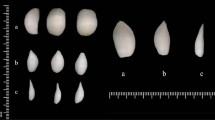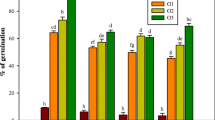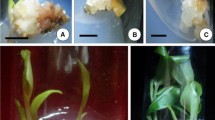Abstract
A highly efficient and reproducible in vitro plant regeneration method has been developed from shoot bud, half-shoot, and shoot slice explants of four genotypes of turmeric (Curcuma longa L.). The shoot slice explant produced the highest number of shoots (22.4 shoots explant−1) than half-shoot (18.6 shoots explant−1) and shoot bud explant (14.2 shoots explant−1) of Salem genotype on medium amended with 13.32 µM 6-benzylaminopurine (BAP) and 5.37 µM 1-naphthaleneacetic acid (NAA). Salem genotype was more efficient among the four genotypes tested, followed by Duggirala Red, Prathibha, and PCT-13 genotypes. Approximately 80% of shoots were induced spontaneous rooting on shoot induction media fortified with NAA. The complete plantlets were obtained after rooting the shoots on a medium augmented with 4.90 µM Indole-3-butyric acid (IBA). IBA was an efficient auxin to induce the maximum number of roots per shoot than Indole-3-acetic acid (IAA) and NAA. The plantlets were acclimatized under greenhouse conditions, and the survival rate was recorded as 96%. The plantlets obtained from all explants were morphologically similar to mother plants. Two genome-based molecular markers, namely inter simple sequence repeats (ISSR) and start codon targeted (SCoT) molecular markers, were employed to determine the genetic stability of plants obtained from the tissue culture of the Salem genotype. The DNA markers validated the genetic uniformity of the plants obtained from all three explants was similar to their mother plant. This plant regeneration procedure could be a helpful method for the genetic improvement of turmeric.



Similar content being viewed by others
References
Adelberg J, Driesse T, Halloran S (2013) Relationships between nutrients and plant density in liquid media during micropropagation and acclimatization of turmeric. In Vitro Cell Dev Biol-Plant 49:724–736
Agarwal T, Gupta AK, Patel AK, Shekhawat N (2015) Micropropagation and validation of genetic homogeneity of Alhagi maurorum using SCoT, ISSR and RAPD markers. Plant Cell Tiss Org Cult 120:313–323
Ammon HP, Wahl MA (1991) Pharmacology of Curcuma longa. Planta Med 57:1–7
Anonymous (2020) Market times report on turmeric. Market Times Tv Pvt. Ltd., Noida, India
Balasubramanian K (2006) Molecular orbital basis for yellow curry spice curcumin’s prevention of Alzheimer’s disease. J Agri Food Chem 54:3512–3520
Behera S, Kamila PK, Rout KK, Barik DP, Panda PC, Naik SK (2018) An efficient plant regeneration protocol of an industrially important plant, Hedychium coronarium J. Koenig and establishment of genetic & biochemical fidelity of the regenerants. Ind Crops Prod 126:58–68
Bejoy M, Dan M, Anish MP (2006) Factors affecting the in vitro multiplication of the endemic Zingiber Curcuma haritha Mangaly and Sabu. Asian J Plant Sci 5:847–853
Bejoy M, Dan M, Anish NP, Nair ARG, Radhika BJ, Manesh K (2012) Micropropagation of an Indian Ginger (Curcuma vamana Sabu and Mangaly): a wild relative of turmeric. Biotechnology 11:333–368
Bharalee R, Das A, Kalita MC (2005) In vitro clonal propagation of Curcuma caesia Roxb and Curcuma zedoaria Rosc from rhizome bud explants. J Plant Biochem Biotech 14:61–63
Cabo S, Ferreira L, Carvalho A, Martins-Lopes P, Martín A, Lima-Brito JE (2014) Potential of start codon targeted (SCoT) markers for DNA fingerprinting of newly synthesized tritordeums and their respective parents. J Appl Genet 55:307–312
Chattopadhyay I, Biswas K, Bandyopadhyay U, Banerjee RK (2004) Turmeric and curcumin: biological actions and medicinal applications. Curr Sci 87:44–53
Cheethaparambil A, Pillai GS, Balachandran I (2013) Comparative studies on in vitro microrhizome induction in three varieties of Curcuma longa (Turmeric)-the role of two stress hormones. Int J Sci Res Manag 1:230–237
Collard BC, Mackill DJ (2009) Start codon targeted (SCoT) polymorphism: a simple, novel DNA marker technique for generating gene-targeted markers in plants. Plant Mol Biol Rep 27:86–93
Das A, Kesari V, Rangan L (2010) Plant regeneration in Curcuma species and assessment of genetic stability of regenerated plants. Biol Plant 54:423–429
Das A, Kesari V, Rangan L (2013) Micropropagation and cytogenetic assessment of Zingiber species of Northeast India. 3Biotech 3:471–479
Downham A, Collins P (2000) Coloring our foods in the last and next millennium. Int J Food Sci Tech 35:5–22
Doyle JJ, Doyle JL (1990) Isolation of plant DNA from fresh tissue. Focus 12:13–15
Egan ME, Pearson M, Weiner SA, Rajendran V, Rubin D, Glockner-Pagel J, Canny S, Du K, Lukacs GL, Caplan MJ (2004) Curcumin, a major constituent of turmeric, corrects cystic fibrosis defects. Science 304:600–602
Gamborg OL, Miller RA, Ojima K (1968) Nutrient requirements of suspension cultures of soybean root cells. Exp Cell Res 50:151–158
Ghosh A, Chatterjee P, Ghosh P (2013) A protocol for rapid propagation of genetically true to type Indian turmeric (Curcuma longa L.) through in vitro culture technique. Adv Appl Sci Res 4:39–45
Gomathy V, Anbazhagan M, Arumugam K (2014) In vitro propagation of Curcuma longa (turmeric). Int J Res Plant Sci 4:30–33
Haque Sk M, Ghosh B (2018) Micropropagation of Kaempferia angustifolia Roscoe-an aromatic, essential oil yielding, underutilized medicinal plant of Zingiberaceae family. J Crop Sci Biotech 21:147–153
He R, Gang DR (2014) Somatic embryogenesis and Agrobacterium mediated transformation of turmeric (Curcuma longa). Plant Cell Tiss Org Cult 116:333–342
Jena S, Ray A, Sahoo A, Sahoo S, Dash B, Kar B, Nayak S (2020) Rapid plant regeneration in industrially important Curcuma zedoaria revealing genetic and biochemical fidelity of the regenerants. 3Biotech 10:17. https://doi.org/10.1007/s13205-019-2009-9
Jena S, Ray A, Sahoo A, Sahoo S, Kar B, Panda PC, Nayak S (2018) High-frequency clonal propagation of Curcuma angustifolia ensuring genetic fidelity of micropropagated plants. Plant Cell Tiss Org Cult 135:473–486
Jie EY, Ahn MS, Lee J, Cheon YI, Kim CY, Kim SW (2019) Establishment of a high-frequency plant regeneration system from rhizome-derived embryogenic cell-suspension cultures of Curcuma longa L. Plant Biotech Rep 13:123–129
Jogam P, Sandhya D, Shekhawat MS, Alok A, Manokari M, Abbagani S, Allini VR (2020) Genetic stability analysis using DNA barcoding and molecular markers and foliar micro-morphological analysis of in vitro regenerated and in vivo grown plants of Artemisia vulgaris L. Ind Crops Prod 151:112476
Jose S, Thomas TD (2015) Abiotic stresses increase plant regeneration ability of rhizome explants of Curcuma caesia Roxb. Plant Cell Tiss Org Cult 122:767–772
Khumaida N, Ardie SW, Setiadi A, Artiningsih LN (2019) In vitro multiplication and acclimatization of black galingale (Curcuma aeruginosa Roxb.). J Appl Pharma Sci 9:110–111
Li H, Sureda A, Devkota HP, Pittala V, Barreca D, Silva AS, Tewari D, Xu S, Nabavi SM (2020) Curcumin, the golden spice in treating cardiovascular diseases. Biotech Adv 38:107343
Manokari M, Priyadharshini S, Jogam P, Shekhawat MS (2020) Application of seismo-mechanical stress in attenuation of in vitro induced abnormalities in Scaevola taccada (Gaertn.) Roxb. Biocat Agri Biotech 29:101821
Meenakshi N, Sulikeri GS, Krishnamoorthy V, Hedge RV (2001) Standardization of chemical environment for multiple shoot induction of turmeric (Curcuma longa L.) for in vitro clonal propagation. Crop Res 22:449–453
Mohanty P, Behera S, Swain SS, Barik DP, Naik SK (2013) Micropropagation of Hedychium coronarium J. Koenig through rhizome bud. Physiol Mol Biol Plants 19:605–610
Mohanty S, Panda MK, Subudhi E, Acharya L, Nayak S (2008) Genetic stability of micropropagated ginger derived from axillary bud through cytophotometric and RAPD analysis. Z Naturforsch 63c:747–754
Murashige T, Skoog F (1962) A revised medium for rapid growth and bioassays with tobacco tissue cultures. Physiol Plant 15:473–497
Muthukumar M, Kumar TS, Rao MV (2016) Organogenesis and evaluation of genetic homogeneity through SCoT and ISSR markers in Helicteres isora L., a medicinally important tree. South Afr J Bot 106:204–210
Nair KP (2019) Turmeric (Curcuma longa L.) and ginger (Zingiber officinale Rosc.) - world’s invaluable medicinal spices. Springer Nature. https://doi.org/10.1007/978-3-030-29189-1
Nayak S (2000) In vitro multiplication and microrhizome induction in Curcuma aromatica Salisb. Plant Growth Reg 32:41–47
Nayak S, Kaur T, Mohanty S, Ghosh G, Choudhury R, Acharya L, Subudhi E (2011) In vitro and ex vitro evaluation of long term micropropagated turmeric as analyzed through cytophotometry, phytoconstituents, biochemical and molecular markers. Plant Growth Reg 64:91–98
Parida R, Mohanty S, Kuanar A, Nayak S (2010) Rapid multiplication and in vitro production of leaf biomass in Kaempferia galanga through tissue culture. Elect J Biotech 13:1–8
Pikulthong V, Teerakathiti T, Thamchaipenet A, Peyachoknagul S (2016) Development of somatic embryos for genetic transformation in Curcuma longa L. and Curcuma mangga Valeton & Zijp. Agri Nat Resources 50:276–285
Prakash S, Elangomathavan R, Ignacimuthu S, Kathiravan K, Seshadri S (2004) Efficient regeneration of Curcuma amada Roxb. plantlets from rhizome and leaf sheath explants. Plant Cell Tiss Org Cult 78:159–165
Prasad S, Aggarwal BB (2011) Turmeric, the golden spice: from traditional medicine to modern medicine. In: Benzie IFF, Wachtel-Galor S (eds) Herbal medicine: biomolecular and clinical aspects. CRC Press/Taylor & Francis Llc, Boca Raton (FL)
Prasad S, Gupta SC, Tyagi AK, Aggarwal BB (2014) Curcumin, a component of golden spice: from bedside to bench and back. Biotech Adv 32:1053–1064
Prathanturarug S, Chuakul W, Phaidee Y, Saralamp P, Soonthornchareonnon N (2003) High-frequency shoot multiplication in Curcuma longa L. using thidiazuron. Plant Cell Rep 21:1054–1059
Prathanturarug S, Soonthornchareonnon N, Chuakul W, Phaidee Y, Saralamp P (2005) Rapid micropropagation of Curcuma longa using bud explants pre-cultured in thidiazuron-supplemented liquid medium. Plant Cell Tiss Org Cult 80:347–351
Priyadharshini S, Kannan N, Manokari M, Shekhawat MS (2020) In vitro regeneration using twin scales for restoration of critically endangered aquatic plant Crinum malabaricum Lekhak & Yadav: a promising source of galanthamine. Plant Cell Tiss Org Cult 141:593–604. https://doi.org/10.1007/s11240-020-01818-1
Ravindran PN, Nirmal Babu K, Shiva KN (2007) Botany and crop improvement of turmeric. In: Ravindran PN, Nirmal Babu K, Sivaraman K (eds) Turmeric: the genus Curcuma. CRC Press, London, pp 15–70
Rohela GK, Jogam P, Bylla P, Reuben CT (2019) Indirect regeneration and assessment of genetic fidelity of acclimated plantlets by SCoT, ISSR and RAPD markers in Rauwolfia tetraphylla L.: an endangered medicinal plant. BioMed Res Int Article ID 3698742, 14 pages, https://doi.org/10.1155/2019/3698742
Rohela GK, Jogam P, Mir MY, Shabnam AA, Shukla P, Abbagani S, Kamili AN (2020) Indirect regeneration and genetic fidelity analysis of acclimated plantlets through SCoT and ISSR markers in Morus alba L. cv. Chinese white. Biotech Rep 25:e00417. https://doi.org/10.1016/j.btre.2020.e00417
Roopadarshini V (2010) High-frequency shoot multiplication and callus regeneration of turmeric. Int J Biotech Biochem 6:723–733
Rout GR, Pala SK, Samantaray S, Das P (2001) Effect of growth regulator and culture and culture conditions on shoot multiplication and rhizome formation in ginger (Zingiber officinale Rosc.) in vitro. In Vitro Cell Dev Biol-Plant 37:814–819
Rout GR, Palai SK, Samantray S, Das P (1995) Metabolic changes during in vitro multiplication of Curcuma longa cvs. Suroma and PTS-28. Acta Bot Hung 39:383–392
Roy S, Raychaudhuri S (2004) In vitro regeneration and estimation of curcumin content in four species of Curcuma. Plant Biotechnol 21:299–302
Sadhu SK, Jogam P, Thampu RK, Abbagani S, Penna S, Peddaboina V (2020) High efficiency plant regeneration and genetic fidelity of regenerants by SCoT and ISSR markers in chickpea (Cicer arietinum L.). Plant Cell Tiss Org Cult 141:465–477
Sahoo S, Singh S, Sahoo A, Sahoo BC, Jena S, Kar B, Nayak S (2020) Molecular and phytochemical stability of long term micropropagated greater galanga (Alpinia galanga) revealed suitable for industrial applications. Ind Crop Prod 148:e112274
Salvi ND, George L, Eapen S (2000) Direct regeneration of shoots from immature inflorescence cultures of turmeric. Plant Cell Tiss Org Cult 62:235–238
Salvi ND, George L, Eapen S (2002) Micropropagation and field evaluation of micropropagated plants of turmeric. Plant Cell Tiss Org Cult 68:143–151
Sarma I, Deka AC, Sarma S, Sarma TC (2011) High frequency clonal propagation and microrhizome induction of Curcuma longa L. (cv Lakadong)-a rich source of curcumin of Northeast India. The BioScan 6:11–18
Shirgurkar MV, John CK, Nadgauda RS (2001) Factors affecting in vitro microrhizome production in turmeric. Plant Cell Tiss Org Cult 64:5–11
Shirgurkar MV, Naik VB, von Arnold S, Nadgauda RS, Clapham D (2006) An efficient protocol for genetic transformation and shoot regeneration of turmeric (Curcuma longa L.) via particle bombardment. Plant Cell Rep 25:112–116
Shukla SK, Shukla S, Koche V, Mishra SK (2007) In vitro propagation of tikhur (Curcuma angustifolia Roxb.): a starch yielding plant. Ind J Biotech 6:274–276
Sinchana NS, Kattimani KN, Prabhuling G, Sudesh K, Jagadeesha N (2020) Standardization of tissue culture protocol for turmeric (Curcuma longa L.) cv. Salem Int J Chem Stud 8:2721–2726
Singh S, Kuanar A, Mohanty S, Subudhi E, Nayak S (2011) Evaluation of phytomedicinal yield potential and molecular profiling of micropropagated and conventionally grown turmeric (Curcuma longa L.). Plant Cell Tiss Org Cult 104:263–269
Singh SR, Dalal S, Singh R, Dhawan AK, Kalia RK (2013) Evaluation of genetic fidelity of in vitro raised plants of Dendrocalamus asper (Schult. & Schult. F.) Backer ex K. Heyne using DNA-based markers. Acta Physiol Plant 35:419–430
Sunder Raju C, Aslam A, Shajahan A (2015) High-efficiency direct somatic embryogenesis and plant regeneration from leaf base explants of turmeric (Curcuma longa L.). Plant Cell Tiss Org Cult 122:79–87
Thakur J, Dwivedi MD, Sourabh P, Uniyal PL, Pandey AK (2016) Genetic homogeneity revealed using SCoT, ISSR and RAPD markers in micropropagated Pittosporum eriocarpum Roylean endemic and endangered medicinal plant. PLoS One 11:e0159050
Thingbaijam DS, Khumallambam DD, Kshetrimayum P, Chongtham HS, Shagolsem BS, Chingakham BS, Huidrom SD (2012) Silver nitrate and different culture vessels influence high frequency microrhizome induction in vitro and enhancement growth of turmeric plantlet during ex vitro acclimatization. Not Sci Biol 4:67–78
Tyagi RK, Agrawal A, Dua P, Yusuf A (2004) In vitro plant regeneration and genotype conservation of eight wild species of Curcuma. Biol Plant 48:129–132
Ugochukwu SC, Bob SE, Ozioma O, Odii EB, Ijeoma IC, Olanike O (2013) Shoot proliferation of in vitro turmeric (Curcuma longa L.) affected by different concentrations of benzylaminopurine (BAP). World J Agri Sci 9:227–230
Wu K, Zhang X, Sun S, Wang X (2015) Factors affecting the accumulation of Curcumin in microrhizomes of Curcuma aromatica Salisb. Article ID 740794, 10 pages. https://doi.org/10.1155/2015/740794
Zuraida AR (2013) Improved in vitro propagation of Curcuma caesia, a valuable medicinal plant. J Trop Agric Food Sci 41:273–281
Acknowledgements
The authors are grateful to the Department of Biotechnology (DBT), Ministry of Science and Technology, Government of India for providing financial assistance in the form of a project (No. BT/PR3732/NDB/39/215/2011, 5th July 2012).
Author information
Authors and Affiliations
Contributions
BP and PJ performed all experiments. RKT, SA, and VP participated in the experiments and writing of the manuscript. SA and VP reviewed the final manuscript. VP designed and supervised the entire work. All the authors read and approved the manuscript.
Corresponding author
Ethics declarations
Conflict of interest
The authors declare no competing interests.
Rights and permissions
About this article
Cite this article
Pittampalli, B., Jogam, P., Thampu, R.K. et al. High-frequency plant regeneration and genetic homogeneity assessment of regenerants by molecular markers in turmeric (Curcuma longa L.). In Vitro Cell.Dev.Biol.-Plant 58, 169–180 (2022). https://doi.org/10.1007/s11627-021-10226-9
Received:
Accepted:
Published:
Issue Date:
DOI: https://doi.org/10.1007/s11627-021-10226-9




